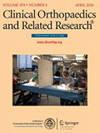No Association Between Growth Hormone Therapy and Upper Extremity Physeal Tension Injuries: A Matched Case-control Study.
IF 4.2
2区 医学
Q1 ORTHOPEDICS
引用次数: 0
Abstract
BACKGROUND Recent evidence has identified a strong association between growth hormone therapy and physeal injuries in the lower extremity; however, few studies have investigated this association in the upper extremity. QUESTIONS/PURPOSES (1) Do pediatric patients with physeal tension injuries of the shoulder and elbow have higher odds of having exposure to recombinant growth hormone therapy than matched controls? (2) Are the odds of having exposure to recombinant growth hormone therapy in physeal tension injuries different when stratified by shoulder and elbow injuries? METHODS Using a matched case-control study design, patients between 4 and 18 years of age treated at a large, urban, academic center from February 1, 2016, to November 6, 2023, were identified by ICD-10 codes using EPIC SlicerDicer, an electronic medical record-based data mining tool. Patients diagnosed with physeal tension injuries in the shoulder or elbow were included in the case group, and those with midshaft radius, metaphyseal radius, or both-bone forearm fractures were included in the control group. A total of 618 patients with physeal injuries and 1244 with non-physeal fractures were identified and screened for inclusion. After further chart review to confirm diagnoses, 46% (283) of patients with physeal injuries and 54% (670) of patients with non-physeal fractures were included. A further 6% (16) of patients with physeal injuries and 2% (15) of patients with non-physeal injuries were excluded due concomitant dislocations or missing data, resulting in 267 eligible patients with physeal injuries and 655 eligible patients with non-physeal fractures. Two patients with concurrent elbow and shoulder physeal injuries were additionally excluded from stratified analyses. Patients with physeal injuries and non-physeal fractures were 1:1 matched by age ± 0.5 years, sex, and BMI ± 2 kg/m2. In all, 522 patients were included in the analysis, including 261 patients with physeal injuries and 261 with non-physeal fractures. The mean ± SD ages for both patient groups was 13 ± 2 years (p = 0.44), 88% (229 of 261) of all participants were male, and the mean BMIs were 19.9 ± 3.0 kg/m2 and 19.4 ± 3.0 kg/m2 (p = 0.11), respectively. Growth hormone exposure was compared between patients with physeal injuries and non-physeal fractures using a conditional logistic regression model. RESULTS Overall, 4% (10 of 261) of patients with physeal injuries had exposure to growth hormone therapy as compared with 2% (4 of 261) of patients with non-physeal fractures (OR 2.5 [95% confidence interval 0.8 to 8.0]). Subgroup analyses of shoulder and elbow injuries demonstrated no difference in growth hormone exposure between patients with physeal injuries and non-physeal fractures (OR 2 [95% CI 0.4 to 10.2] and OR 3 [95% CI 0.6 to 14.9], respectively). CONCLUSION In light of these results, clinicians may not need to advise precaution against sports or other activities that put the upper extremity physes under stress when treating patients with growth hormone supplementation therapy. Future multicenter studies, however, are indicated to further investigate for the existence of any subtle association between growth hormone therapy and upper extremity physeal injuries relative to the large association previously noted in the lower extremity in pediatric and adolescent patients. LEVEL OF EVIDENCE Level III, therapeutic study.生长激素治疗与上肢骨骺拉力损伤之间无关联:一项匹配病例对照研究
背景最近的证据表明,生长激素治疗与下肢趾骨损伤之间存在密切联系;然而,很少有研究对上肢的这种联系进行调查。问题/提案(1)与匹配的对照组相比,肩部和肘部趾骨张力损伤的儿科患者接受重组生长激素治疗的几率更高吗?(2)按肩部和肘部损伤分层,趾骨张力损伤患者接受重组生长激素治疗的几率是否不同?方法采用匹配病例对照研究设计,使用基于电子病历的数据挖掘工具EPIC SlicerDicer,通过ICD-10代码识别2016年2月1日至2023年11月6日期间在一家大型城市学术中心接受治疗的4至18岁患者。确诊为肩部或肘部趾骨张力损伤的患者被纳入病例组,桡骨中轴、桡骨骺或双骨前臂骨折的患者被纳入对照组。经过筛选,共有 618 名骨干损伤患者和 1244 名非骨干骨折患者被纳入病例组。经进一步病历审查确诊后,46%(283 例)的趾骨损伤患者和 54%(670 例)的非趾骨骨折患者被纳入对照组。另有6%(16名)的趾骨损伤患者和2%(15名)的非趾骨损伤患者因同时脱位或数据缺失而被排除在外,因此符合条件的趾骨损伤患者有267名,符合条件的非趾骨骨折患者有655名。分层分析中还排除了两名同时患有肘部和肩部趾骨损伤的患者。趾骨损伤和非趾骨骨折患者的年龄(± 0.5 岁)、性别和体重指数(± 2 kg/m2)均为 1:1。共有 522 名患者被纳入分析,其中包括 261 名趾骨损伤患者和 261 名非趾骨骨折患者。两组患者的平均年龄(± SD)均为 13 ± 2 岁(P = 0.44),所有参与者中有 88% (261 人中的 229 人)为男性,平均体重指数分别为 19.9 ± 3.0 kg/m2 和 19.4 ± 3.0 kg/m2 (P = 0.11)。结果总体而言,4%的趾骨损伤患者(261例中的10例)接受过生长激素治疗,而2%的非趾骨骨折患者(261例中的4例)接受过生长激素治疗(OR值为2.5[95%置信区间为0.8-8.0])。对肩部和肘部损伤进行的分组分析表明,骨骺损伤患者与非骨骺骨折患者在生长激素暴露方面没有差异(OR 分别为 2 [95% CI 0.4 至 10.2] 和 OR 3 [95% CI 0.6 至 14.9])。不过,未来的多中心研究应进一步调查生长激素治疗与上肢趾骨损伤之间是否存在微妙的关联,而不是像之前在儿童和青少年患者下肢中发现的那样存在巨大关联。
本文章由计算机程序翻译,如有差异,请以英文原文为准。
求助全文
约1分钟内获得全文
求助全文
来源期刊
CiteScore
7.00
自引率
11.90%
发文量
722
审稿时长
2.5 months
期刊介绍:
Clinical Orthopaedics and Related Research® is a leading peer-reviewed journal devoted to the dissemination of new and important orthopaedic knowledge.
CORR® brings readers the latest clinical and basic research, along with columns, commentaries, and interviews with authors.

 求助内容:
求助内容: 应助结果提醒方式:
应助结果提醒方式:


